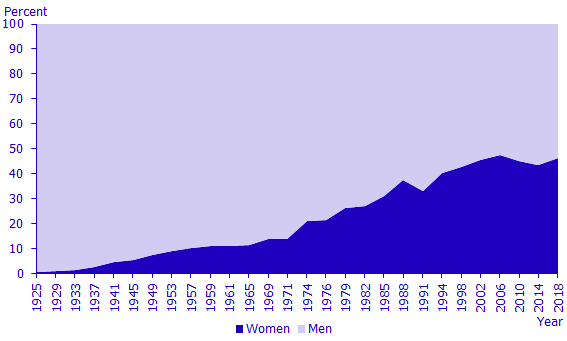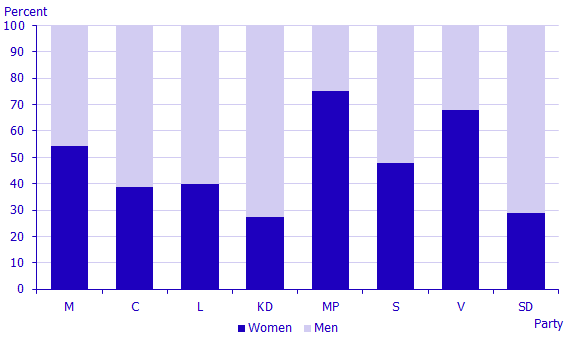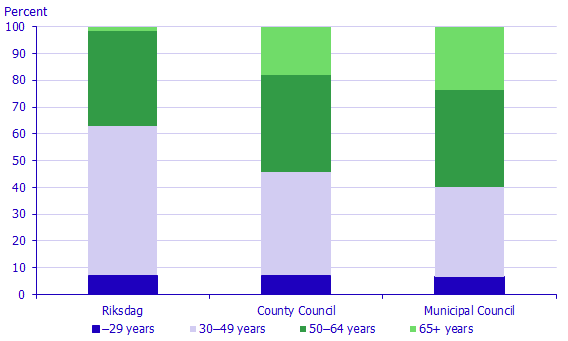Nominated and elected candidates, 2018
Gender imbalance in five out of eight Riksdag parties
Statistical news from Statistics Sweden 2019-03-28 9.30
Slightly more women were elected to the Riksdag in 2018 compared with in the previous election, but in five out of eight Riksdag parties, there is a gender imbalance. The proportion of persons who are young, old, foreign born, have a low level of education, or have low income is smaller among elected representatives than among eligible voters as a whole.
Statistics Sweden is now publishing its survey on the candidates who were nominated and elected in the 2018 general elections. Corresponding statistics on the voting population are being published at the same time. The survey on nominated and elected candidates describes how representative our elected political bodies are.
Slightly more women in the Riksdag than after the 2014 general elections
In the whole country in total, there has not been any instance when more women than men were elected to the Riksdag, county councils, or municipal councils. In the Riksdag, 46.1 percent of the elected candidates are women, up by 2.5 percent compared with 2014. This is the largest share of women elected to the Riksdag since 2006. However, in county councils and municipal councils, the share of women declined marginally compared with 2014, and amounted to 47.6 percent and 43.3 percent respectively.

The representation of women and men in the Riksdag can be regarded as balanced among the members of the Moderate Party, Social Democrat Party, and the Liberal Party. “Balanced” is defined here to mean that the shares of men and women lie in the interval 40 to 60 percent. In the Green Party and the Left Party, the share of women is larger than 60 percent. Among the Christian Democrats, Sweden Democrats, and the Centre Party, the share of elected men is larger than 60 percent. This means that five out of eight parties represented in the Riksdag do not have what is considered to be gender balance among their elected representatives.

M=Moderate Party, C=Centre Party, L=Liberal Party, KD=Christian Democrats, MP= Green Party, S= Social Democrats, L=Left Party and SD=Sweden Democrats.
The members of the Riksdag are younger than elected representatives in the county councils and municipalities. The average age is 45 years among those elected to the Riksdag, 51 years among those elected to county councils, and among those elected to municipal councils, the average age is 53 years. The members of the Riksdag are young, which is also clear from the size of the different age groups. Most members of the Riksdag are aged 30–49 years and account for 56 percent of all members. This age group is also most overrepresented, compared with the voting population. At the other end, two percent of the members of the Riksdag are 65 years and older. This makes it the most underrepresented age group among the members of the Riksdag.

In county councils and municipal councils, primarily the youngest members, 18–29 years, are underrepresented among the elected representatives, compared with the voting population. The most overrepresented age group among elected representatives at regional and local level are 50–64 year olds. At regional and local level, the share of those aged 65 years and older among elected representatives is also slightly smaller compared with the size of this age group in the voting population.
Definitions and explanations
In the 2018 general election, as usual, 349 members were elected to the Riksdag, 1 696 members were elected to the 20 county councils in Sweden, and 12 679 members were elected to the 290 municipal councils in Sweden. In municipal councils, 21 seats in total were not filled, referred to as "empty seats". These statistics are based on the candidates elected on 9 September 2018.
Statistical Database
More information is available in the Statistical Database
Feel free to use the facts from this statistical news but remember to state Source: Statistics Sweden.
